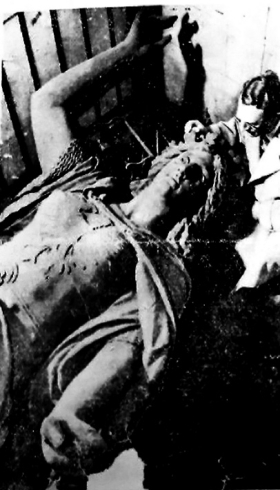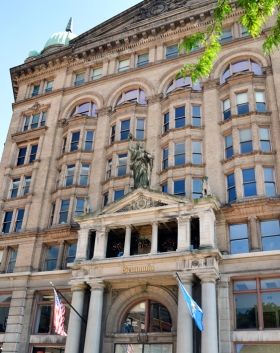The Mystery of the Germania Statue
It’s the city’s greatest art heist. How did a monumental, three-ton bronze statue disappear?
H Russell Zimmermann, sometimes called Wisconsin’s preeminent architectural historian, began writing stories about Milwaukee architecture for the Milwaukee Journal in 1967 and in 1987 published “Magnificent Milwaukee: Architectural Treasures 1850-1920.” In 1981, he began crawling through belfries and basement corners looking for any trace of Germania in the Brumder Building.

Germania lies in the basement of the Milwaukee Auditorium with wholesale scrap dealer Clyde Scott examining the statue. Courtesy: H. Russell Zimmermann, from his book Germania Building: A Milwaukee Landmark Restored” (1982).
Zimmermann had been commissioned by the building’s new owners to do research on the family and offices during a restoration. They wanted to put the statue back on the plinth and reclaim the name “Germania.” His research ultimately led to the publication of a 46-page book offering the most compelling and accurate telling of the statue’s legend (Zimmermann provided much help to Urban Milwaukee in telling this story). Nowadays, he still consults on restorations and helped pen one of the two recent books on Cyril Colnik.
Even though all the participants in the Germania story were long gone by 1981, Zimmermann still tried to interview relatives, widows and descendants who might offer clues. But he came up empty until running across the forgotten photo of Germania’s last resting place in the Milwaukee Auditorium’s basement. Yet no one seemed to know it had once been abandoned there.
Gretchen Colnik became a local TV personality, something like Milwaukee’s Martha Stewart, in the 1950s. She gave an interview to Jay Joslyn of the Milwaukee Sentinel in 1981, claiming that later in the war, “a more successful effort to salvage the statue was made despite my father’s pleas…the wire declaring the statue a piece of art arrived a day after it was shipped off…it could be hidden some place in the Smithsonian Institution where father [Cyril] had sent her.”
This story, which conflicted with past accounts of Germania’s fate, pushed Zimmermann to contact the Smithsonian’s war storage department in the 1980s—but they could find nothing. More recently, Urban Milwaukee contacted several of the Smithsonian’s art and history departments who could find no record of the statue being stored there. A department head later assured us that museum records are now up to date and they would have recorded the statue had it ever arrived.
Urban Milwaukee then went to Villa Terrace Museum, where Colnik’s blueprints and sketches were donated. There we found his 1938-1945 ledger, and while it’s a fascinating read of who’s who and features future star items on Antiques Roadshow, the only entry of possible relevance to Germania was on July 6, 1943, noting some sections of copper, iron and bronze being sold for an unnamed price to a metals recovery firm—but there is no mention of 6,000 pounds worth in the form of giant woman.
Another columnist a few years back speculated that Germania could have been buried in the plots Colnik had gained from Wisconsin Memorial Park. The theory seems far-fetched, and in any case Gretchen sold the plots in the 1970s to raise campaign funds for former mayor Frank Zeidler when he ran for president as the Socialist Party candidate.
Not all of Cyril Colnik’s papers went to Villa Terrace. Some were obtained by E.J.’s second cousin Nicholas Brumder, who became a famous ironworks artist himself and now lives in New Zealand. He stated via email that his collection is only blueprints and drawings—not personal papers.
If the Brumder vaults held any records, E.J. states they were destroyed in 1963 when the North American Press inherited any such documents as part of a business deal, then moved to South Milwaukee and threw all the historic paperwork into a dumpster.
While all the hard evidence has been destroyed or forgotten, there was one fourth-hand account that Zimmermann says he left out of his book. He says that one of the old Germania Building docents once met a secretary in the 1960s who had worked in the Milwaukee Auditorium. She stated that it was so shocking and sad to see a giant arm hanging over the side of gondola cart near the freight elevators. Is it proof that the Germania was broken down and destroyed? Not quite, but it is a pretty specific memory, and a haunting image of culture being disassembled.
If the statue was destroyed, there may be still remnants of it somewhere. In the photos of Germania in hiding, both in Colnik’s workshop and the Auditorium basement, her hands were empty and no longer held the bronze crown or imperial sword representing the Holy Roman Empire. For someone so inclined, those items would have made terrific souvenirs.























Phenomenal article… nice work guys!
Great right up! More thorough then the old newspaper accounts in the past. Good visuals too.
The best article I’ve read so far from Urban Milwaukee.
Incredible story; very well told. It seems like a long shot, but hopefully one day someone finds this statue.
While I’m sure the history isn’t quite that compelling, anyone have an idea of where the sword shown in this photo from the Aug 7, 1926 (Milwaukee Sentinel) ended up? http://milwaukier-than-thou.tumblr.com/image/57845171826 The base is still in Juneau Park, but it is empty.
Comically enough, Hereiam, on tumblr and flickr I am known as “blurradial”. I knew about this rock for some time and even its origin, but only recently did I begin to wonder what went in the 4-5 inch hole in the top.
After a little searching, I found that photo of the sword in the stone and posted it to M-T-T. It is more likely a vandalism theft, one that no one in Milwaukee remembers or has said anything about even when it happened. So yes, we add the top of an Excalibur sword to a short list of MIA MKE monument and statues. I found most of the others, but not that one.
Sirs/MS: In early 1940’s my Mom worked in Brumder Bldg. downtown. Like many German-speaking central Europeans, the Brumders are, and REMAIN, a cornerstone with their HARD work and genius, inc. positive contributions for what “makes Milwaukee famous!” We can truly be thankful, D. Jaeger PS Thanks for excellent research!
Thanks for the great read, Brian! Discovered this Colnik ad in the City Hall library and thought you might enjoy: http://www.flickr.com/photos/cityofmilwaukee/9516675469/in/set-72157632988298436
Thanks, Tina. I did see that scan in my research–I think it’s from a well-run directory around the turn of the century called “Caspar” (a bookseller in town who published guides, sort of like a Fodor’s meets Yellow Pages). It is important to note the address–Greenbush Street–which led me to Colnik’s unpublished 2nd factory and forge which he was bought out of by 1915.
Gee Whiz B. I just finished page three of your magnificently researched piece. You sure know how to spin a tale. Give us more. Give us more.
Thanks for this great investigative report, even if in the end it remains a mystery (and indeed, a broken-up arm lolling out of a freight cart is so sad). But also thanks for mentioning off hand what happened to all (many?) of the old cannon in city parks and monuments. For a city its size, Milwaukee has virtually no military hardware on display and I could never figure out what had happened to it. Can you tell me if W.E. Simons’ collection reports are available that might have documented what was scrapped?
Great story! Having learned from both Zimmerman and Wilson (author of Colnik book) ; I have heard this story many times over my blacksmith career. Never had I heard some of the follow up. Thanks for keeping Milwaukee history pertinent!